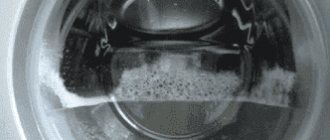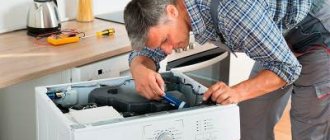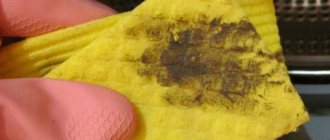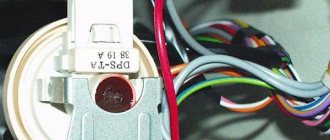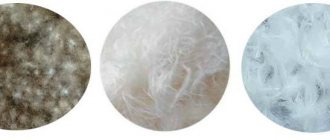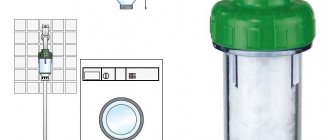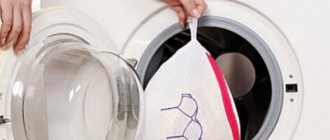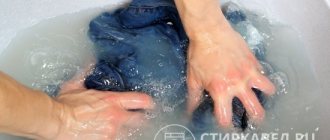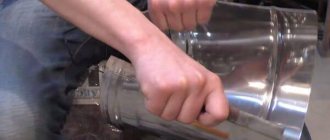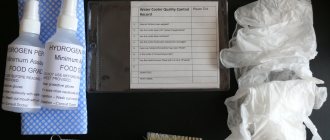There are water softeners for washing machines. Its service life is significantly reduced by scale formed as a result of unprotected washing in hard water. SMA requires careful treatment of yourself. Let's consider what are the best means to use to soften.
- Why washing in soft water is preferable
- Hardness parameters
- Determination of hardness
- Norms
- Chemical softening
- Mechanical softening
- Traditional methods of water softening
- Preventive measures and cleaning of washing machine elements
- Catalog of washing machines with reviews
Why washing in soft water is preferable
Washing clothes in a softened environment saves not only the energy and time of the housewife, but also the resource of the automatic machine itself.
- In the first case, there is no need to wash heavily soiled items or rinse them again.
- In the second, the machine lasts longer, without becoming unusable due to the accumulation of calcium and magnesium-containing salts on the thermal element and the walls of the tank, without running the risk of mold formation.
Water softener
Criterias of choice
High-quality salt must not contain foreign impurities.
Tablet salt must meet certain quality requirements:
- tablets should not be colored;
- the size of a quality product decreases gradually when dissolved;
- The cleaner contains no additives.
Mandatory certification for salt in tablets on Russian territory is not necessary, and some manufacturers take advantage of this by mixing cheap rock salt with high-quality salt. The resulting product is inexpensive, but its quality is low. When purchasing such salt based on economic considerations, there is a risk of reducing the service life of filtration devices. This is especially true for filters with ion exchange resins and reverse osmosis systems.
Hardness parameters
Hardness is a physical and chemical property of water associated with the presence of metal salts in it - calcium, magnesium - in a dissolved state.
You can understand that water is oversaturated with salts by the following signs:
- the appearance of an unpleasant odor from inside the car;
- accumulation of powder residues in the tray for detergent components, rubber seal, drain pipe;
- lack of foaming during the cycle;
- the appearance of a gray-white coating on the glass of the car door, on the walls of the tank;
- the presence of stains on clothes, determining the quality of washing as unsatisfactory, including because an increased consumption of detergent is noticed.
All of the above troubles most often manifest themselves after processing the laundry at a temperature of 60°C; with slight heating to 30-40°C, scale formation is not observed. However, the latter circumstance does not negate the use of environmental softeners in conditions of high salt content.
Expert opinion
I work in the household appliance repair industry. Extensive experience in restoring washing machines and dishwashers.
Ask a Question
The fact of an excess of magnesium and calcium compounds in water also confirms the appearance of a film on the surface both when soap is completely dissolved in it, and during normal settling without adding detergents.
How to determine hardness?
The easiest way is to use a special card. You can also use a conductometer - this is a device for measuring electrical conductivity. It is also called a “salt meter”. The higher the number on the screen, the more salts and harder the liquid. What signs can be used to judge an increased concentration of salts:
- Detergents do not foam well;
- Scale forms in the kettle after just a few boils;
- Bitter taste - however, not everyone feels it;
- The formation of a white coating on the walls of the container after settling.
Determination of hardness
The following methods are known for determining the degree of sample rigidity:
- In addition to everyday methods for identifying properties, there are laboratory methods that are more informative and reliable. They are not available to everyone.
- An alternative is to measure electrical conductivity, temperature, and salt levels in a liquid medium with a conductometer. The “salt meter,” as it is also called, displays on the screen a digital expression of the amount of salts in the sample; the higher it is, the harsher the medium.
- Digital quality testers are gaining popularity. They determine the presence of organic and inorganic compounds, as well as heavy metals. By their quantity one can judge the properties of the liquid being tested.
- There is a map that shows the predominance of certain chemicals in tap water in different areas of the state, indicating health risks. The information on the map is rather for informational purposes, as it does not provide accurate numerical data other than general ones.
Water softener
Magnetic processing method
Another universal solution of our time. This water softener can even reliably protect your washing machine from breakdowns.
By purchasing the simplest model called “Aquashield”, you can easily eliminate the dangerous effects of hard salts in pipes, the total length of which is from seven hundred to eight hundred meters. All taps, boilers and other products should be added to this section of the water supply system.
Such a magnetic generator is quite cheap and consumes up to five watts of electrical energy per hour of operation. It is easy to calculate that connecting it to the network on a permanent basis will increase electricity consumption slightly in one month.
With its ease of use, such a unit will satisfy the wishes of any demanding consumer. It does not contain replaceable parts or special fillings. The working process and configuration of the device are carried out automatically.
In terms of its efficiency, the electromagnetic transducer is considered the best example of a product. It is capable of fulfilling its functional purpose in any water, regardless of the amount and type of impurities present in it. The operating modes in the device should not be changed.
Anyone can install such equipment. To do this, a wire of fifteen to twenty turns is wound onto a piece of pipe, and the generator is connected to the electrical network. The working life is designed for two decades.
Norms
The following units of measurement are known: degrees of hardness, volume fractions, mass numbers, mol/m3, mg-eq/l.
According to the latest measuring system, in mEq/l, the types of water conditions are distinguished:
- soft – less than 2;
- normal – from 2 to 4;
- hard – from 4 to 6;
- very hard – from 6.
For clarity, degrees define liquid as:
- soft – less than 2;
- medium – from 2 to 10;
- very hard – above 10.
For example, in European countries, a level of 1 or 2 mEq/L is taken as normal, and in Russia – 7 mEq/L. This indicator already indicates a high salt content in the sample, but is not considered critical, although it needs to be reduced due to softening additives.
Are you unplugging your washing machine?
Oh yes! No
Chemical softening
To soften, special chemicals that have the desired ability are added to the washing solution.
The list shows the most popular and effective of them:
- Specialized additives – known from advertising as “Calgon” and others like it. These are added to the washing composition, if they are powdery, in the corresponding compartment of the tray - in gel form, in the tank - in tablet form. They make the washing solution softer, protect machine parts and prevent the problem of scale accumulation. It is important to follow the recommended doses.
- Powders with emollients - some of the detergent compositions include them (for example, Persil, Ariel). The specified rate will already contain the required amount of softener.
Kalgon
Mechanical softening
Mechanical methods also help make water less hard. This refers to various devices called filters. It is believed that the use of such systems is more effective than the use of chemical compounds.
There are several types of filters:
- Coarse cleaning - there is a mesh in the body that traps large particles, such as rust. The filter requires periodic cleaning. It is mounted at the point where the main pipe communicates with the hose of the automatic machine.
- Magnetic - captures metals from the liquid flowing through them by means of a magnetic field that directs the salts into the sump. Such filters last a long time, they are reliable, and are not in the low price category. Installed on highways and water pipes.
Do you turn off the water tap after washing?Oh yes! No.
- Polyphosphate or salt - in them the softening function is performed by polyphosphate crystals, during the reaction with which calcium and magnesium salts are neutralized. This filter must be replaced every six months during daily operation of the machine. This deficiency is compensated by the result of filtration: lime deposits do not cover the heating element, and the quality of washing improves. It has a low cost. It is cut into the water supply pipe and then connected to the inlet hose.
- Ionic ones do an excellent job of removing metal impurities. Ions that react with metals in one part of the filter penetrate into the water. The salt crystals contained in the second part of the device trap ions with metallic inclusions.
- Membrane, combo filters or reverse osmosis systems are a design made of three or more parts separated by membranes. Each of them contains solutions of different densities and concentrations that purify the water passing through them from impurities and heavy metals. It overcomes membranes under a certain pressure. For domestic needs, the use of combo filters is considered suitable. Liquid filtered in this way is unsuitable for consumption, since the process deprives it of not only harmful, but also beneficial components.
Filters for water
Water filters
These elements are used to soften and purify water from all kinds of impurities. To do this, they are simply installed in the intake hose of the washing machine.
Note that filters are different:
- saline is the cheapest option, and for this reason it is accessible. Polyphosphate crystals soften water, significantly improving quality,
- magnetic filter – capable of retaining metal particles. The element is versatile and is used even when purifying water intended for drinking. The filter element is reliable, its price is much higher,
- ionic – salt accumulations of especially heavy metals settle in the working compartments. After passing through such filtration, the water becomes much softer,
- osmosis - perfectly removes hardness, purifies water from salts and metallic impurities.
The use of chemicals and filters helps to give the washing process maximum effect. All things retain their softness and fluffiness.
Traditional methods of water softening
So-called “folk” products also help soften water:
- A chemical compound from the category of cheap and productive is soda ash. It is poured into the tray of the automatic machine, into the compartment for detergents, in a 1:1 ratio with washing powder, if it is necessary to reduce the high degree of hardness; with the addition of half the norm if the value is average. There are restrictions on the use for machine cleaning of products made from natural fabrics.
- Laundry soap - you will need about 150 g of it. Rub it on a grater, add 5 liters of water, stir until dissolved and leave for several hours, preferably overnight. After time, a kind of washing gel is formed, which is drained without sediment. Up to 3 teaspoons of boric alcohol are added to the product and used for washing clothes of adults and older children.
- Wood ash (oak or beech) is taken in an amount of 2.5 g, stirred in 1 liter of water, and left for 8 to 12 hours.
- An inexpensive, accessible product, approved even by washing machine service specialists, is citric acid. It is added directly to the car tank in the amount of 80 g. It is widely and successfully used in many homes.
- Vinegar is used at the stage of rinsing clothes. It is able to neutralize calcium and magnesium containing salts remaining on clothing after a work cycle.
- A solution of washing powder with laundry soap is obtained by mixing 1 liter of water with 3 g of soap and one spoon of powder. It is required to stand for 8-10 hours.
- Tablet salt is used, rather, not for the process of cleaning laundry from dirt, but to get rid of scale. The tablet is placed in the tank of the machine, and a “idle” cycle is carried out without things.
Soda
What else can you use?
The above list can be supplemented with, perhaps, only one remedy: baking soda. It is not as aggressive as calcified, and has no contraindications for use, unlike that one.
Methods for using baking soda are simple:
- Pour 100 g of product into the drum and wash as usual. Baking soda will soften the environment, make it easier to remove stains, and get rid of the unpleasant aroma of any specific contamination. To enhance the effect, add the same amount of wine vinegar to the drum.
- Add soda to the compartment of the detergent tray along with the powder in a 1:1 ratio.
Do you store laundry in the washing machine?
Oh yes! No.
Sodium polyphosphate effect on the body
Is a polyphosphate water filter really that harmless? Most often, polyphosphate filters are installed in front of washing machines and heating boilers to protect heating elements and pipes from scale. This water then ends up in our taps and wastewater. Whether to use water treated with a polyphosphate filter for cooking and drinking is up to you.
- We will only give our recommendations:
- remember that technical polyphosphates are purified worse than food ones;
- try to determine the maximum permissible concentration of phosphates in your water using laboratory analysis and compare it with the daily intake of phosphorus, taking into account the approximate intake of phosphorus from food;
- the daily phosphorus intake rate for adolescents and adults is up to 3-4,000 mg/day;
- Please note that the maximum phosphate content in drinking water and domestic water is 3.5 milligrams per liter of water;
- When washing clothes, polyphosphates tend to linger in the fibers of the fabric; in people with highly sensitive skin, this can cause an allergic reaction.
Is it possible to drink water after a polyphosphate filter?
It is important to understand that water that is purified using such a filter becomes technical and cannot be used for drinking or cooking.
Is the polyphosphate water filter washable?
Speaking about how harmful such a filter is for health, one thing can be said: it is undesirable to use such water for direct contact with the body, since it is a chemical reagent. However, if you put your hands in it if necessary, a chemical burn will not occur due to the low concentration.
Preventive measures and cleaning of washing machine elements
The use of citric acid is recognized as a worthy preventive measure. Above we talked about adding SMA to the drum. But you can put it in the powder compartment along with it and wash it at 60°C. Repetition frequency: 3 times every 6 months, depending on water hardness.
Experts recommend thoroughly rinsing the removable tray to remove powder residues once every 14 days, and clearing the blockage from the filter of the washing unit once every three months. Hair and small debris accumulate there, which can lead to a more serious problem than an unpleasant odor.
Once every 6 months will be enough to clean the drum. The procedure will require dishwashing liquid dissolved in warm water. Use a sponge soaked in this mixture to wipe the inside of the tank, the rubber seal, and the glass of the unit door. After this, wipe dry.
Do not neglect regular cleaning of the machine body. By removing external contaminants, you can notice stains in places hidden from human eyes. In the same sealing gum of the tank.
The use of chemical and mechanical softeners is also a preventative measure, very important for protecting the device.
It must be remembered that washing in water supersaturated with salts wears out the machine faster. At the same time, quality suffers, the consumption of detergents and electricity increases, which entails additional costs. The money spent on the purchase of softeners will ultimately result in savings; they will be justified by extending the life of the washing machine.

